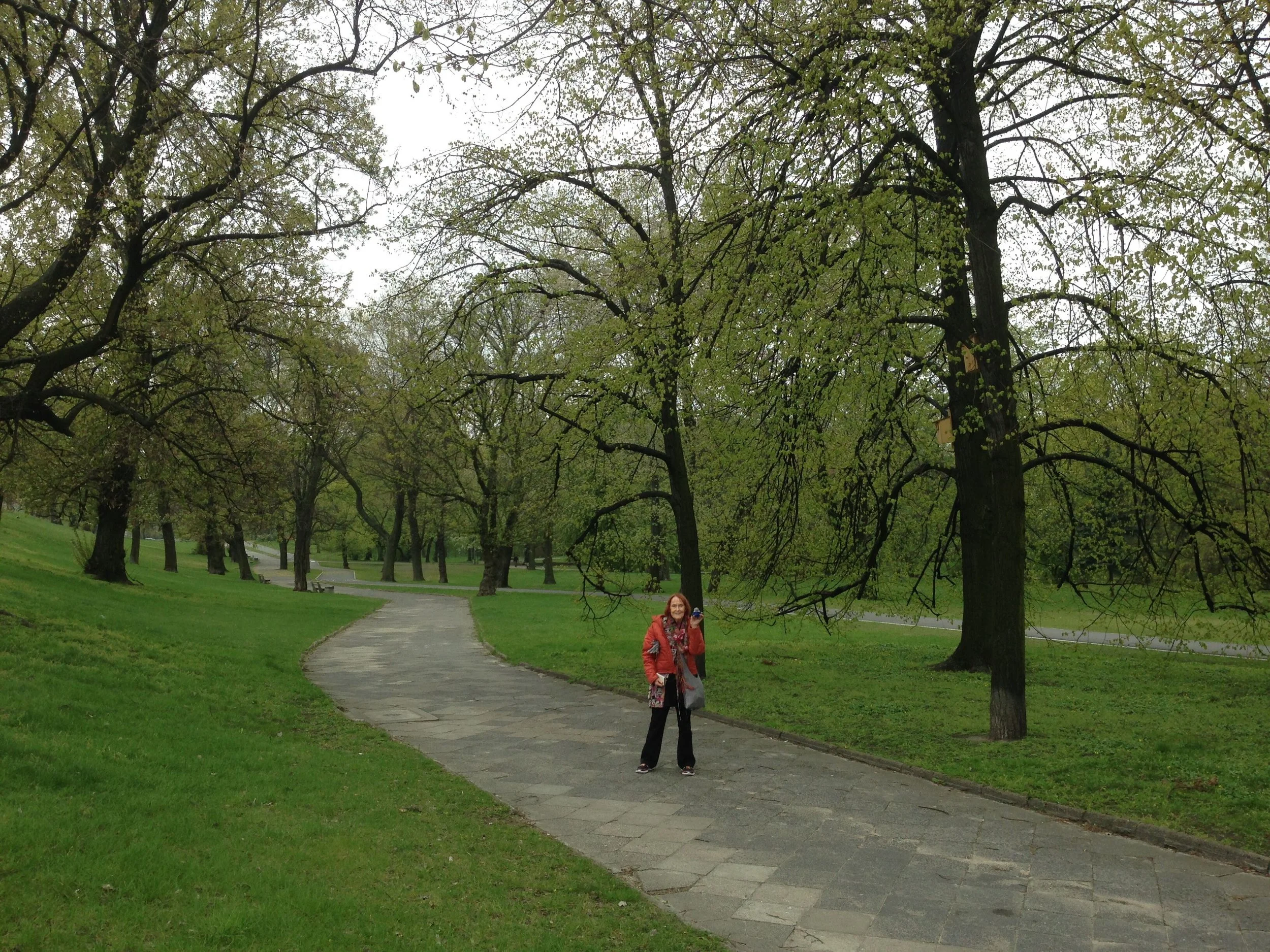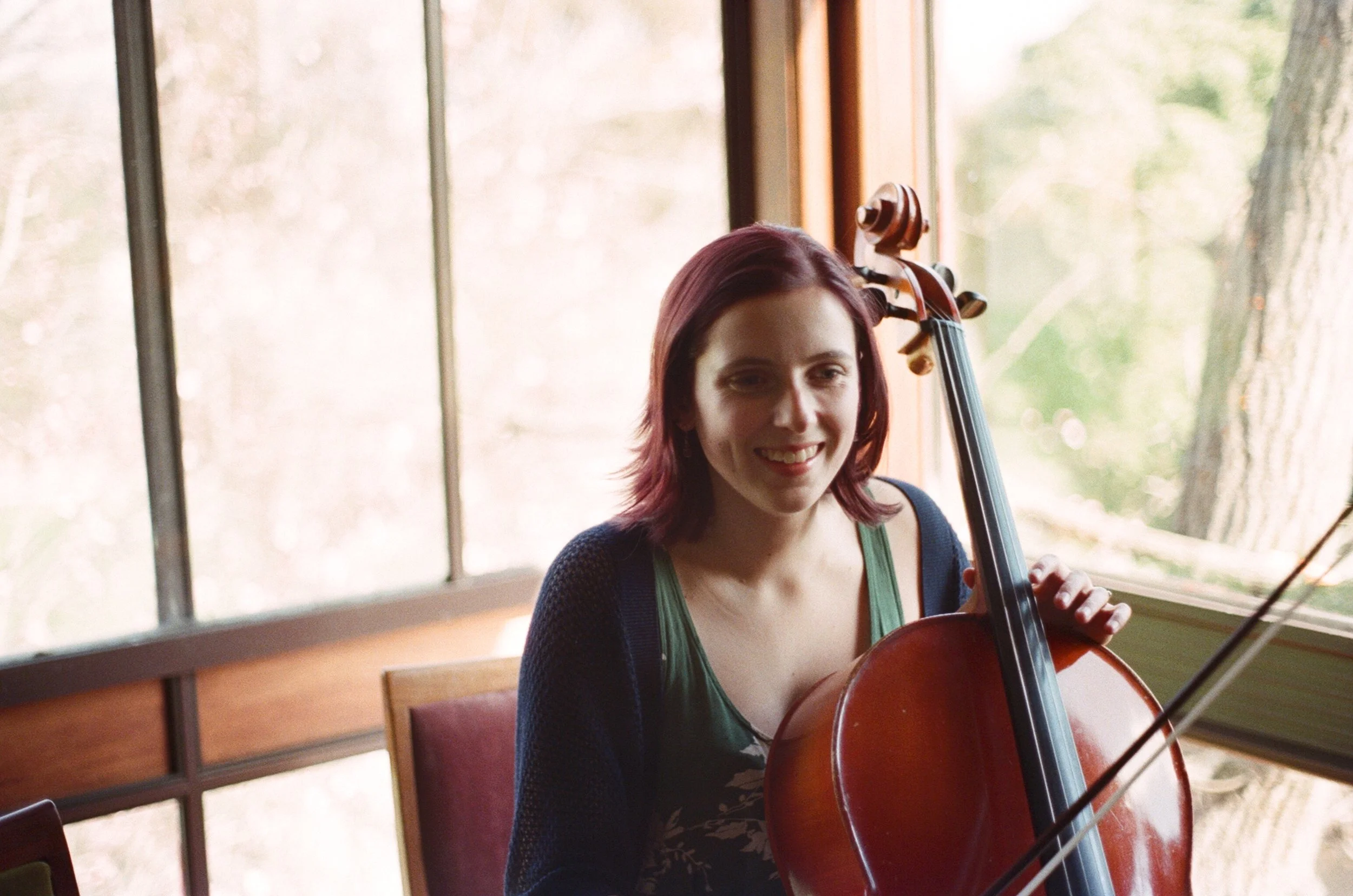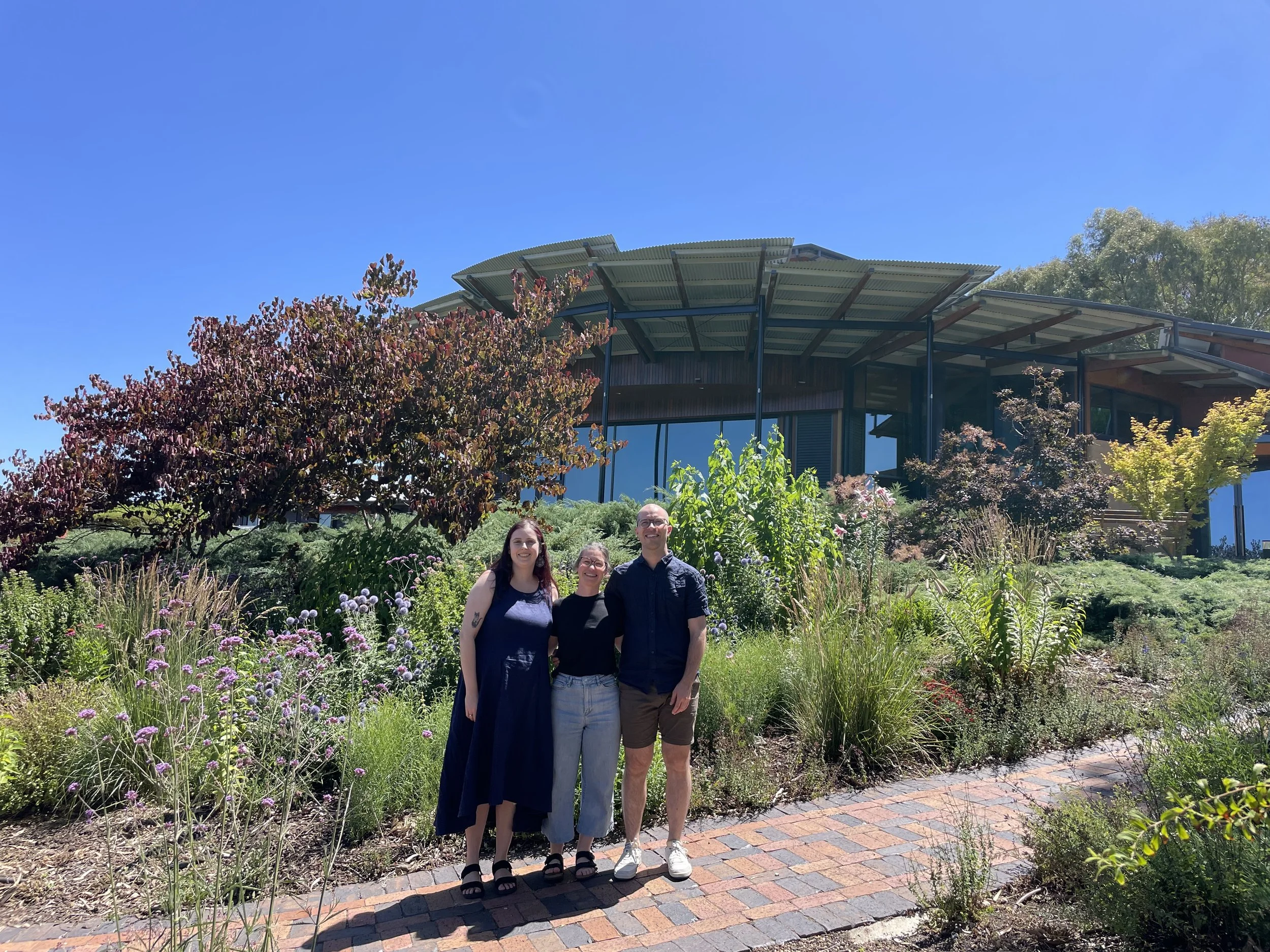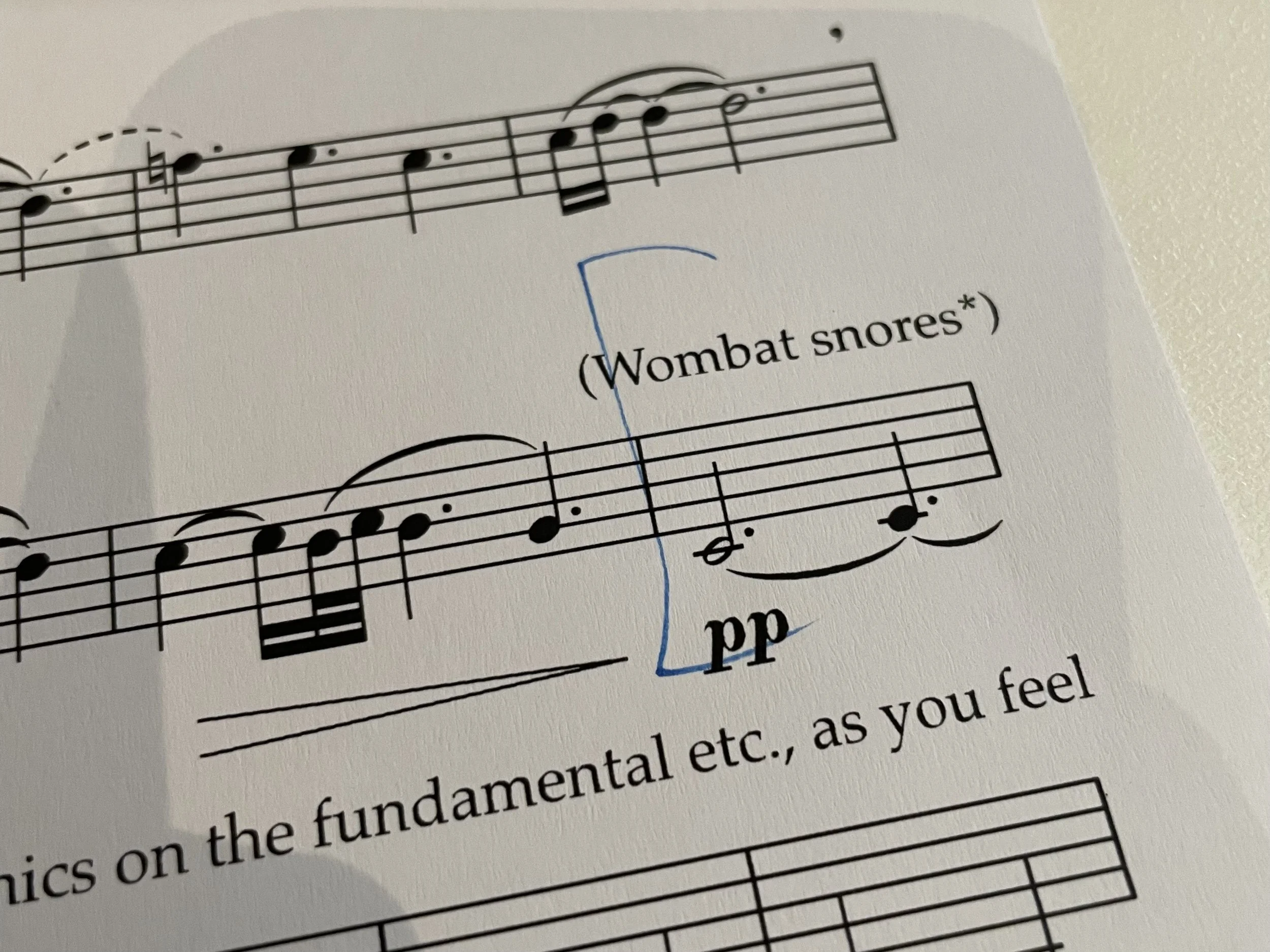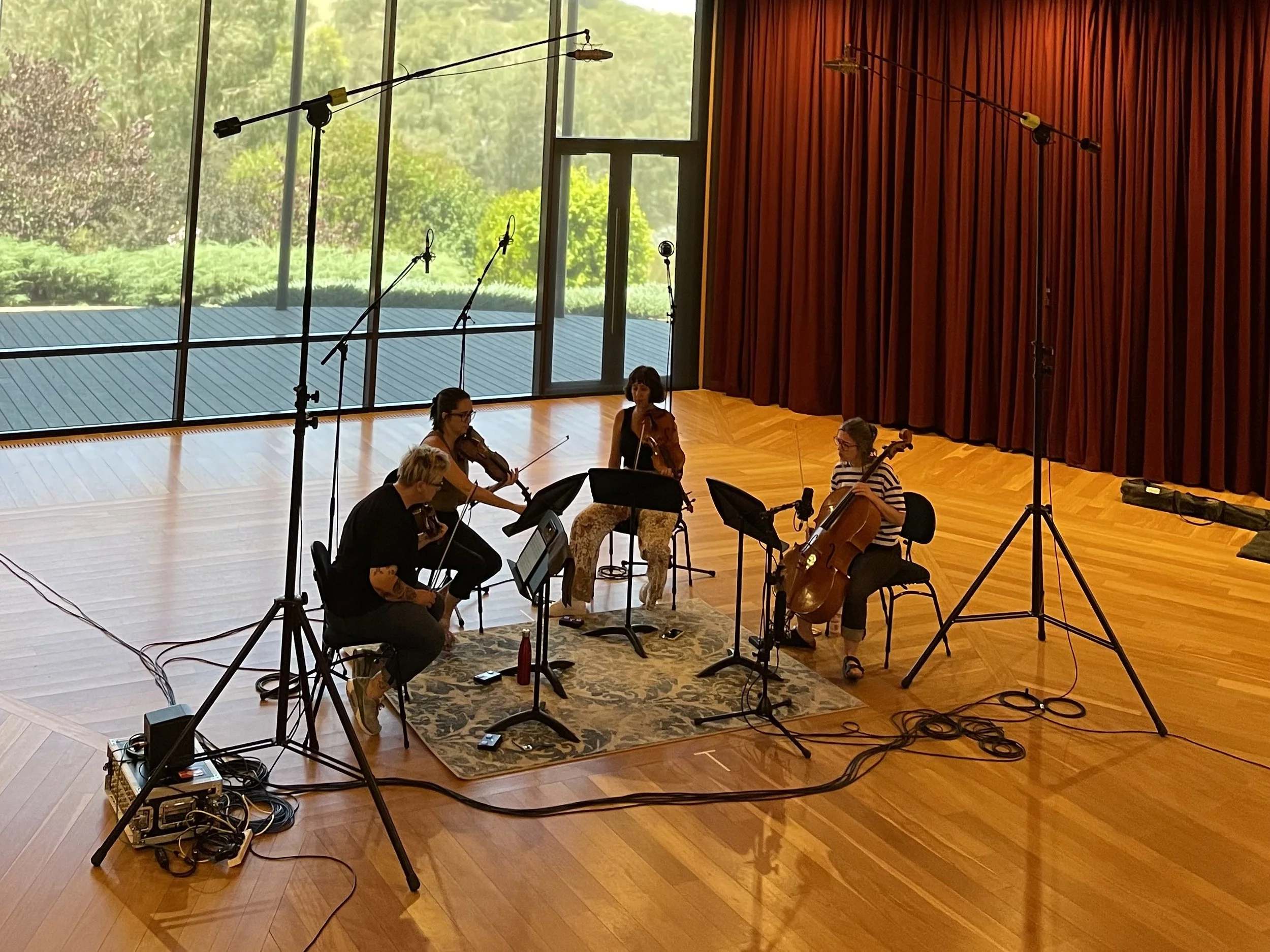TL;DR version: Under the Fig Tree – Music for serenity, strength, and joy, released on Friday 25 July 2025, is my debut album of instrumental chamber music!
There are nine tracks which range from classical guitar and harp duets honouring the three generations of strong women in my immediate family; string quartet arrangements of choral pieces from 2013 and 2019; three tracks featuring cello and/or bassoon fun times; and a string quartet version of my popular string orchestra piece, Dancing on Tiptoes.
The finer details…
If I had decided to print physical CDs of my debut album release, I would have agonised over the liner notes. However, I have not! So, please enjoy this blog of an unspecified length, which explains a bit about Under the Fig Tree – Music for serenity, strength, and joy, released on Friday 25 July 2025.
Pictured above: Me sitting under the largest tree in the City of Marion, South Australia (an impressive Moreton Bay fig)
Firstly: the title. Allow me to indulge and quote from my 2019 Brigid Bruer life celebration speech:
Hi, I’m Rachel – Chloe’s twin sister, Hilary’s daughter, and Brigid’s granddaughter. I’m so proud to be related to these three strong women. I simultaneously have far too much to say, and not nearly enough, so I’ll try to let the music I have written [for Brigid] speak for me.
The piece is called Under the Fig Tree, and I wrote it for her in 2014. She would always tell me: “Rachel, you’re so serene! How are you always so serene?!” … to that I might say, “Well, maybe outwardly?! Just don’t look inside my mind…”
She felt the serenity in this piece, named after the colours she saw in the music – the colour of figs [B major], and the colour of leaves [E major].
Brigid: you have always been, and will always be, loved and worthy.
Pictured above: The woman, the myth, the legend, Brigid Bruer (1933–2019)
This explains the context of the original guitar solo version of Under the Fig Tree – just one movement, and far too many notes for a soloist to comfortably play! This is why, when I first heard the brilliant classical guitar and harp duo of Andrew Blanch and Emily Granger in concert at UKARIA in 2021, I thought… maybe Under the Fig Tree could have a new life. I am incredibly grateful to Andrew, Emily, and the decision makers at Creative Australia and Arts South Australia, for helping to make this happen now in 2025.
The colour palette of classical guitar and harp together is enchanting and exciting – the perfect combination to pay tribute to the force of nature that is Brigid Bruer. As mentioned in my 2019 speech, I come from a family of strong women across three generations: my grandmother Brigid, mother Hilary, and twin sister Chloe. We have all faced challenges in our lives, but our support for one another has been eternal, and to honour these relationships with this new music is a privilege.
Side note – thanks must go to Chloe at this point for granting me permission to steal some melodic fragments from her that she composed back in 2009, when we were in our final year of high school. Chloe, I’ll draw up a contract for you sometime, and then you can have the 7 cents the track might make in streaming royalties.
So, what’s the deal with the rest of this album? Well, from my perspective as a woman in her mid-thirties who is childfree by choice, I’d like to say that the album has had a gestation period of over a decade. It was in 2013, when I was in my first year at the Elder Conservatorium studying a Bachelor of Music in Composition, that I wrote the original version of track 4, The Violet. It was inspired by my time singing in Aurora Vocal Ensemble, composed for upper-voice choir, and originally recorded on Aurora’s debut album, Joyful Girl. The lyrics are about quiet confidence, from the poem of the same name by Jane Taylor (1783–1824), and I quote from the final verse:
Then let me to the valley go,
This pretty flower to see;
That I may also learn to grow
In sweet humility.
As I continue to compose, and continually wrestle with what it might mean to create new music, I like to remember the thoughts and feelings of 2013 me. I think she was, generally, less concerned about her ‘product’ being perfect, because she was still obviously learning – she was a student at a tertiary institution, and she was aware of the privilege of studying composition full-time (and being able to do so because her partner was, conveniently, not a musician, and therefore had some stable income to fall back on). I’m trying to lean in to that energy more these days, because the fact is that we are all continually learning. We don’t have to pretend that we’ve got it all together.
Pictured above: Me in my more optimistic youth
Track 5, Lost, was also originally composed for Aurora, and now arranged for string quartet to sit alongside The Violet. The text was based on the sharing of poems and stories with members of Aurora, surrounding themes of absence, and the melody is based on a chant by Byzantine-Greek composer Kassia (c. 810–c. 865). It was composed in 2019, just after Brigid had suddenly died, so I remember going into my workshop discussion with the singers, and just being extremely sad. I had already decided on the theme for the piece, but the completely unexpected loss of Brigid amplified everything. I often describe Brigid as my replacement father, as my biological father has been emotionally absent for most of my life. He’s still around, so perhaps if he listens to any of this music one day, he might like to reflect on Brigid’s legacy. I’m sure she would cringe reading that, but I think it’s a truth that deserves to be told.
Although these two tracks are, in my mind at least, ‘missing’ their original words in these instrumental arrangements, I still feel and hear those words, and I’d be interested to know what moods others may experience in their listening. The serenity and joy here are intertwined with loss, but I think there is strength in that.
Pictured above: Me, Anna (cello), and Jack (bassoon) on our recording day at UKARIA in December 2024, squinty-eyed in the sun
Track 6, Greening, is my ‘collaboration’ with the visionary Hildegard von Bingen (1098–1179), based on two of her original chants: Ave Generosa, and O Viridissima Virga. If I think back again to my time at the Elder Conservatorium, I remember continually wishing that we learned more about historical women (and living women and gender diverse people for that matter). I don’t remember when I first heard about Hildegard, but I’m pretty sure it was in my own research on women composers rather than in a class. I hope things have changed in the last decade, because everyone should know that the melodic lines of Hildegard are absolute perfection. Fun fact: my three-movement Hildegard concerto used these chants too, and was composed in 2017 for Samantha Webber (clarinet), Daniel Webber (alto sax), and the Adelaide Wind Orchestra. Contact me if you’d like to know more about that large-scale work! Thank you to Jack and Anna, beautiful bassoon and cello duo, for your reimagining.
Track 7, River, was first part of a series of cello duets (2017) that I attempted with some young students, in so-called ‘irregular’ time signatures, but aiming to sound ‘regular’ (this one is in 5). The flowing lines of this solo version played by Anna lead on from the Hildegard chant, and as well as potentially representing a gently flowing river, the specific River being referred to is the name of a special autism assistance dog. Rest in peace, River.
Track 8, Song of the Wombat, was initially commissioned in 2020 by Deborah Shnookal, but was not able to be performed live until November 2021 due to the COVID-19 pandemic. The commission was for a fundraising concert for the Central Victorian Wildlife Hospital, performed by Jack, and dedicated to Momo the wombat, who has since been happily released back into the wild!
Pictured above: The snoring section of the Song of the Wombat score. It’s my nightmare that someone who has never heard my music before might only ever hear the snoring section of this piece. Please, listen to the whole thing, hahahahaha…
I think that Jack describes the piece very well:
“Song of the Wombat depicts a day in the life of a wombat. The day begins, and he [Momo] is snoozing away, dreaming about things. Then he wakes up and starts to search for a burrow. Then he falls back to sleep again, snores for a while, and then Rachel has a direction to play the next section as ‘wombat jazz’, so in my imagination, he’s getting dressed, getting ready for his day to go out, putting his top hat on… and the last section of the piece is another burrowing section in which it’s a bit more frenetic, and then he just disappears down the burrow.” Joyous!
Finally, we come to Track 9, which is a string quartet arrangement of my current ABC Classic one-hit-wonder, Dancing on Tiptoes, originally commissioned by the Hush Foundation in 2017. Dancing on Tiptoes was part of the Hush ‘Collective Wisdom’ project, visiting teenagers in mental health wards of hospitals around the country.
Hush 18 – Collective Wisdom, the album, was released on the ABC Classics label, and originally recorded for string orchestra by the Australian Chamber Orchestra Collective, 2018. My existing program note describes some of the experience:
“It's like dancing on tiptoes, but knowing you're never going to fall...” – a quote from an insightful young person at Adelaide's Women's and Children's Hospital, which sparked the inspiration for this piece. It is a simple, moderate dance in changing [again] so-called ‘irregular’ time signatures. Loudmouth described the melody as happy and sunny: “a mellifluous [what a great word!] theme that fluctuates up and down...”. I hope it helps bring a sense of calm and optimism to anyone who is struggling. I am passionate about caring for the planet, and all animals, including people! Challenging the stigma surrounding mental illness is so important for creating a kinder, more understanding world, which is what the Hush Foundation are contributing so amazingly to. Music can certainly help create this world.
Pictured above: String quartet recording day at UKARIA, December 2024, with Belinda and Emily (violins), Karen (viola), and Anna (cello)
So! That’s all the detail that I’d like to share about Under the Fig Tree – Music for serenity, strength, and joy.
I’d also like to say that it’s pretty satisfying to now be able to point to this album as a partial answer to the question, “Hey Rachel, what kind of music do you write?”
Happy listening,
Rachel
ACKNOWLEDGEMENTS
Under the Fig Tree is dedicated to Brigid Bruer (1933–2019)
And Caellyen Bruerville, you can also be the token man to be acknowledged in birthing this album. Thank you for everything. Thanks for existing.
Rachel Bruerville, composer
Hildegard von Bingen, composer (track 6)
Andrew Blanch, classical guitar
Emily Granger, harp
Belinda Gehlert, violin
Emily Tulloch, violin
Karen De Nardi, viola
Anna Pokorny, cello
Jack Schiller, bassoon
Jakub Gaudasinski, sound engineer
Album artwork by Amanda Ng and Lucy Timbrell
Tracks 1–3 recorded at Lush Recording Studios, Kabi Kabi and Turrbal Country, Clontarf Beach, Queensland, with assistance from sound engineer Bernie Wedrat, October 2024
Tracks 4–9 recorded at UKARIA Cultural Centre, Peramangk Country, Mount Barker Summit, South Australia, with much appreciation to UKARIA for in-kind support, December 2024
This project has been assisted by the Australian Government through Creative Australia, its principal arts investment and advisory body.
This project has also been supported by Arts South Australia.

